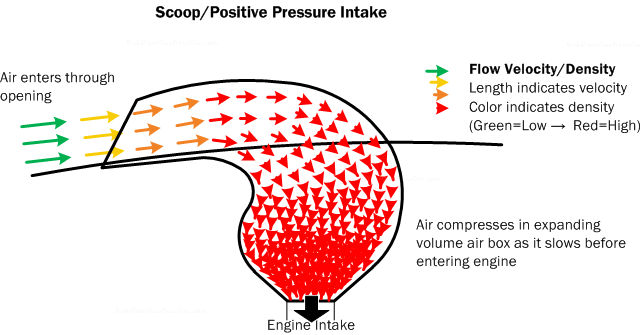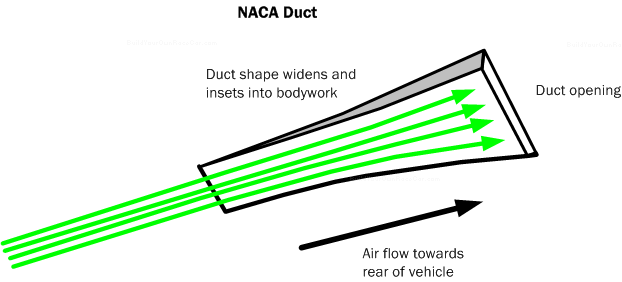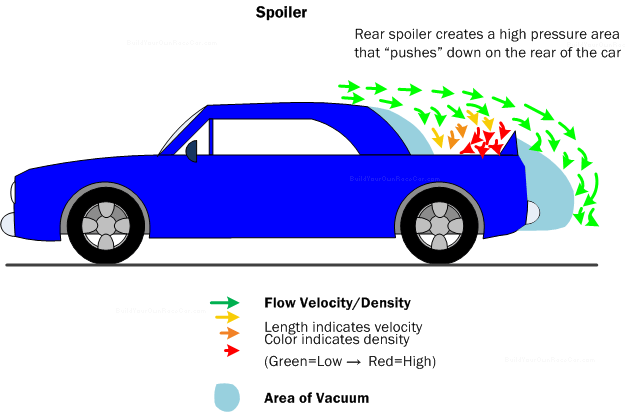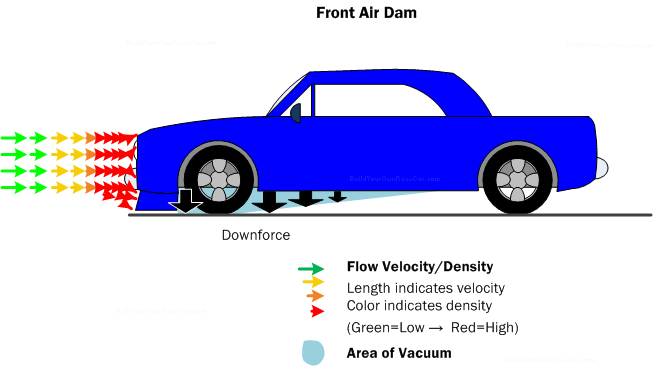Car Aerodynamics Basics and How-To Design Tips cont…
Aerodynamic Devices
Aerodynamic devices provided a means of taking advantage airflow around a vehicle. Some devices increase the effectiveness of airflows within the body of the vehicle, such as those feeding a radiator or engine. Other devices create downforce to increase traction.
Scoops/Positive pressure intakes
Scoops, or positive pressure intakes, are useful in providing a mild “Ram Air” or “Supercharging” effect to a combustion engine. They work on the principle that the air flow compresses inside an “air box” when subjected to a constant and oncoming flow of air. The air box has an opening that permits an adequate volume of air to enter, and the expanding air box itself slows the air flow to increase the pressure inside the box. The faster the vehicle travels, the greater the pressure increase and air volume through the air box. Diagram AD1 below shows a scoop and air box:

Diagram AD1. Scoops or intakes direct the flow of cool air into an expanding airbox which allows the air pressure to increase, creating more horsepower.
NACA Ducts
NACA ducts are useful when air needs to be drawn into an area which isn’t exposed to the direct oncoming air flow the scoop has access to. Quite often NACA ducts will be used along the sides of a vehicle. The NACA duct takes advantage of the Boundary layer, a layer of slow moving air that “clings” to the bodywork of the car, especially where the bodywork flattens, or does not accelerate or decelerate the air flow. Areas like the roof and side body panels are good examples. The longer the roof or body panels, the thicker the layer becomes (a source of drag that grows as the layer thickens as well).

Diagram AD2. The NACA duct (named after the National Advisory Committee for Aeronautics) is a specially shaped duct that pulls air from the boundary layer inside the vehicle.
The NACA duct scavenges this slower moving area by means of a specially shaped intake. The intake shape, shown below in diagram AD2, drops in toward the inside of the bodywork, and this draws the slow moving air into the opening at the end of the NACA duct. Vortices are also generated by the “walls” of the duct shape, aiding in the scavenging. The shape and depth change of the duct are critical for proper operation.
Typical uses for NACA ducts include engine air intakes and cooling.
Spoilers
Spoilers are used primarily on sedan-type race cars and road cars to provide downforce, but also to counteract the natural tendency of these cars to become “light” in the rear due to lift generated by the rear body shape.
Spoilers act like barriers to air flow, in order to build up higher air pressure in front of the spoiler. This higher pressure acts upon the area of the trunk/deck to provide downforce. Diagram AD3 below shows how the flow is manipulated to increase pressure.

Diagram AD3. The spoiler creates a barrier that increases air pressure and flow attachment ahead of it.
Front Air Dam
A Front air dam is used to prevent air from flowing underneath a vehicle. It does this by creating a “dam” or wall across the front of the vehicle that extends close down to the road and usually along the sides to some extent. This creates an area of vacuum or low pressure underneath the car as shown in diagram AD4 below. This low pressure area, in combination with the higher pressures above the front and top of the vehicle, generates downforce at the front of the vehicle.

Diagram AD4. The front air dam blocks air from going under the vehicle. This creates a low pressure area immediately behind the air dam. Which provides downforce. However, without side skirts, air soon enters from the sides to equalize the pressure underneath the car which diminishes downforce further back.
If we extend the air dam along the sides of the vehicle to become “skirts”, we can extend the vacuum or low pressure area generated under the vehicle by the air dam as well.
Aerodynamics How-To Tips (3/4)
Use Aerodynamics to Assist Vehicle Operation
Using vehicle bodywork to direct airflow into openings, for instance, permits more efficient, smaller openings that reduce drag penalties. Quite often, with some forethought, you can gain an advantage over a competitor by these small dual purpose techniques.
Another useful technique is to use the natural high and low pressure areas created by the bodywork to perform functions. For instance, Mercedes, back in the 1950s placed radiator outlets in the low pressure zone behind the driver. The air inlet pressure which fed the radiator became less critical, as the low pressure outlet area literally sucked air through the radiator.
A useful high pressure area is in front of the car, and to make full use of this area, the nose of the car is often slanted downward. This allows the higher air pressure to push down on the nose of the car, increasing grip. It also has the advantage of permitting greater driver visibility.
Keep Protrusions Away From The Bodywork
The smooth airflow achieved by proper bodywork design can be destroyed quite easily if a protrusion such as a mirror is too close to it. While it is important to design an aerodynamic mount for a mirror, the mirror itself needs to be placed far enough away from the bodywork to avoid adverse affects.
49 2 40 7


